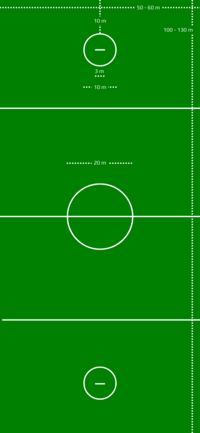Sandbox:Volghar
This article is incomplete because it is pending further input from participants, or it is a work-in-progress by one author. Please comment on this article's talk page to share your input, comments and questions. Note: To contribute to this article, you may need to seek help from the author(s) of this page. |
| Highest governing body | Sukranumput Kesatuan (SK) |
|---|---|
| Nicknames | Pelangi handball, Coian handball, lawn handball |
| Characteristics | |
| Contact | Full |
| Team members | 10 per side |
| Mixed gender | No |
| Type | Team sport Outdoor |
| Equipment | Handball |
| Venue | Handball lawn |
| Presence | |
| Country or region | Pelangi Coius |
Pelangi handball (Pelangi: Sukanrumput), also known as Coian handball or lawn handball is a Pelangi full-contact team sport played between two teams of ten players on a rectangular grass pitch who pass the ball between themselves primarily by using their hands. The aim of the sport is to throw the ball into the goal of the opposing team. A standard match consists of two halves of 40 minutes, and the team that scores more goals within that period wins.
Players may advance the ball up the pitch using any part of their body. However, feet may only be used when the ball is on the ground, and punting is not a permitted act. Pelangi handball is played on an outdoor pitch measuring between 100 metres and 130 metres long and 50 metres to 60 metres wide. Each goal sits 10 metres from the end line, and is located within a circular crease measuring 10 metres in diameter.
History
Rules
Summary
Two teams of ten players (nine outfield players and one goal tender) take to the lawn and attempt to score points by putting the ball into the opposing team's ball. Players are permitted to use any part of their body in moving the ball forward, except for their feet, with the following exceptions: the ball can be struck with the feet provided that the player has not held the ball prior to the kick in the same play, the goaltender is permitted to use their feet and punt the ball provided they are in their crease.
In moving the ball up the lawn, players are not required to dribble or bounce the ball. However, they are open to be tackled by any opposing player. In making a tackle, there are no limits to the angle from which a player may strike. However, they are not permitted to tackle above the shoulders. Upon being held stationary on the ground, the tackled player is required to release the ball. Should they not, play is stopped and the tackling player may restart play with possession.
One player, usually the goaltender, must remain behind the half-way line at all times. Other than the goaltender, both defensive and offensive players are not permitted to enter the goal crease.
Lawn
Pelangi handball fields are known as 'lawns'. Lawns are variable in length, but at the top level, they are always between 100-130 metres in length and 50-60 metres in width. Lines are marked at halfway, and at each quarter-line. A centre circle, with a diameter of 20 metres, is set at the middle of the lawn. Two goal creases, each 10 metres in diameter, are located 10 metres away from the end of each side of the lawn. Players are permitted to move behind these creases at all times during play. A goal three metres in width and two metres in height is located in the centre of these creases.
Duration
A standard match consists of two halves of 40 minutes. A 20 minute intermission takes place at half-time, after which the teams return to the lawn and the the direction of play switches. Match officials keep track of time, with time not stopped unless the head official calls for it. Otherwise, injury time is added to end of each half to make up for periods of time lost due to injuries or the ball being knocked out of play.
Positions
Traditionally, positions (with the exception of the goaltender) are divided into thirds: forwards, midfielders and backs. However, in recent years, a more flexible approach has been taken with respect to how teams will line up against one another. Regardless, each traditional position is assigned a respective number, and the starting player in each line up, regardless of the formation taken by that particular team, will take to the lawn with the number associated with their nominal position, these numbers are as follows:
- Goaltender
- Left Back
- Centre Back
- Right Back
- Right Wing
- Centre
- Left Wing
- Left Forward
- Centre Forward
- Right Forward
Teams have five substitutes, and an unlimited number of substitutes can be made per match.
